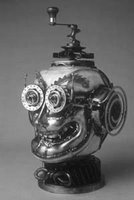
That's the title of a
book (2003, Farrar, Straus & Giroux) by the late
Susan Sontag.
''Let the atrocious images haunt us. Even if they are only tokens, and cannot possibly encompass most of the reality to which they refer, they still perform a vital function. The images say: This is what human beings are capable of doing -- may volunteer to do, enthusiastically, self-righteously. Don't forget.''Images are one thing. We shouldn't forget them. But what happens to a person when he loses his empathy?
US soldier's rape sentence cut due to Iraq stress
By Robin Pomeroy, Reuters
ROME, March 7 (Reuters) - A U.S. soldier who raped a Nigerian woman in Italy was given a lighter sentence because the court deemed his tour of duty in Iraq had made him less sensitive to the suffering of others.
And what sort of empathy did the Italian judges feel for the Nigerian victim??Continuing on the topic of empathy and its instantiation in the neural goo, another new paper in
Brain (
Rankin et al., 2006) looked at a group of patients who have the neurodegenerative syndrome called
frontotemporal dementia, a clinical variant of
frontotemporal lobar degeneration (FTLD).

The brief picture told in the figure above is that
lower levels of empathy corresponded most significantly with atrophy of the right temporal pole, the right anterior fusiform gyrus and the right medial inferior frontal cortex.
Rankin KP, Gorno-Tempini ML, Allison SC, Stanley CM, Glenn S, Weiner MW, Miller BL. (2006). Structural anatomy of empathy in neurodegenerative disease. Brain Sep 28; [Epub ahead of print]
Empathy is a complex social behaviour mediated by a network of brain structures. Recently, several functional imaging studies have investigated the neural basis of empathy, but few corroborative human lesion studies exist. Severe empathy loss is a common feature of frontotemporal lobar degeneration (FTLD), and is also seen in other neurodegenerative diseases. In this study, the neuroanatomic basis of empathy was investigated in 123 patients with FTLD, Alzheimer's disease, corticobasal degeneration and progressive supranuclear palsy using the Interpersonal Reactivity Index (IRI). IRI Empathic Concern and Perspective taking scores were correlated with structural MRI brain volume using voxel-based morphometry. Voxels in the right temporal pole, the right fusiform gyrus, the right caudate and right subcallosal gyrus correlated significantly with total empathy score. Empathy score correlated positively with the volume of right temporal structures in semantic dementia, and with subcallosal gyrus volume in frontotemporal dementia. These findings are consistent with previous research suggesting that a primarily right frontotemporal network of brain regions is involved in emotion processing, and highlights the roles of the right temporal pole and inferior frontal/striatal regions in regulating complex social interactions. This is the first large-scale lesion study to investigate the neural basis of empathy using correlational analytic methods. The results suggest that the right anterior temporal and medial frontal regions are essential for real-life empathic behaviour.Of course, loss of empathy can be observed in many other disorders for which we don't have any clear-cut notion of the underlying neuropathology, including
PTSD (Farrow et al., 2005),
psychopathy (Blair et al., 2006; Kiehl, 2006; Larsson et al., 2006; Sommer et al., 2006),
autism (Anckarsater, 2006; Wheelwright et al., 2006),
schizophrenia (Langdon et al., 2006), and
depersonalization/derealization (Hunter et al., 2004), and other conditions for which we do (e.g.,
spinocerebellar ataxia type 8).
Finally, there's a review in
TICS on empathy and the brain.
de Vignemont F, Singer T. (2006). The empathic brain: how, when and why? Trends Cog Sci. 10:435-41.

Recent imaging results suggest that individuals automatically share the emotions of others when exposed to their emotions. We question the assumption of the automaticity and propose a contextual approach, suggesting several modulatory factors that might influence empathic brain responses. Contextual appraisal could occur early in emotional cue evaluation, which then might or might not lead to an empathic brain response, or not until after an empathic brain response is automatically elicited. We propose two major roles for empathy; its epistemological role is to provide information about the future actions of other people, and important environmental properties. Its social role is to serve as the origin of the motivation for cooperative and prosocial behavior, as well as help for effective social communication.ReferencesAnckarsater H. (2006). Central nervous changes in social dysfunction: autism, aggression, and psychopathy.
Brain Res Bull 69:259-65.
Blair RJ, Peschardt KS, Budhani S, Mitchell DG, Pine DS. (2006). The development of psychopathy.
J Child Psychol Psychiatry 47:262-76.
Hunter EC, Sierra M, David AS. (2004). The epidemiology of depersonalisation and derealisation. A systematic review.
Soc Psychiatry Psychiatr Epidemiol 39:9-18.
Kiehl KA. (2006). A cognitive neuroscience perspective on psychopathy: evidence for paralimbic system dysfunction.
Psychiatry Res 142(2-3):107-28.
Langdon R, Coltheart M, Ward PB. (2006). Empathetic perspective-taking is impaired in schizophrenia: evidence from a study of emotion attribution and theory of mind.
Cognit Neuropsychiatry 11:133-55.
Larsson H, Andershed H, Lichtenstein P. (2006). A genetic factor explains most of the variation in the psychopathic personality.
J Abnorm Psychol 115:221-30.
Sommer M, Hajak G, Dohnel K, Schwerdtner J, Meinhardt J, Muller JL. (2006). Chapter 25 Integration of emotion and cognition in patients with psychopathy.
Prog Brain Res 156C:457-466.
Wheelwright S, Baron-Cohen S, Goldenfeld N, Delaney J, Fine D, Smith R, Weil L, Wakabayashi A. (2006) Predicting Autism Spectrum Quotient (AQ) from the Systemizing Quotient-Revised (SQ-R) and Empathy Quotient (EQ).
Brain Res 1079:47-56.


































